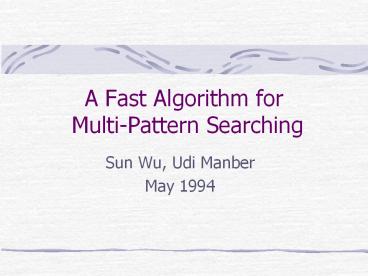A Fast Algorithm for Multi-Pattern Searching PowerPoint PPT Presentation
1 / 20
Title: A Fast Algorithm for Multi-Pattern Searching
1
A Fast Algorithm for Multi-Pattern Searching
- Sun Wu, Udi Manber
- May 1994
2
Basic Idea
- Boyer-Moore Starts by comparing the last
character. - Uses the skip idea of Boyer-Moore to multiple
patterns. (Bad character shift) - Looking text in blocks instead of one by one
char. - Hash functions and tables are used.
3
The preprocessing stage
- The minimum length of a pattern, m, and consider
only the first m chars of each pattern. - ?if k patterns, total size .
- Three tables to build a SHIFT table, a HASH
table, and a PREFIX table.
4
Scanning steps
- 1. Compute a hash value h based on the current B
characters from the text (starting with
). - 2. Check the value of if gt0, shift
and back to 1. - 3. Compute the hash value of the prefix of the
text call it text_prefix. - 4. Check for each p,
whether . When
they are equal, check the actual pattern against
the text directly.
5
SHIFT table
- SHIFT table
- Let B be the size of the block, each string of
size B in the alphabet is mapped to an index to
the SHIFT table by a hash function. - 1.X doesnt appear
(not m) - 2.X appears q is the
position that X ends in some pattern. - Set to the minimum value.
6
HASH table
- The same hash function as SHIFT table.
- Map the last B chars of all patterns.
- contains a pointer that
- Points to a list of pointers of the patterns
whose last B characters hash into i. - is an index to the PREFIX table.
7
PREFIX table
- Map the first B chars of all patterns into the
PREFIX table. - Contains the hash value of each prefix of size
B. - Used to filter patterns whose suffix is the same
but whose prefix is different.
8
HASH table
SHIFT table
PREFIX table
SHIFTi
SHIFTi1
Pattern pointer list
- Hash i
Hash i1
9
Performance
- entries in SHIFT
table, constructed in time . - It takes to compute one hash function,
the total amount of work in the cases of non-zero
shifts is . - Assume BB, then the amount of work for the case
of shift value 0 is also , the expected
total amount for this step is also .
10
(No Transcript)
11
A comparison of different search routines on a
15.8MB text
- Above figure
- Pattern sizesranging from 5 to 15 with average
size slightly above 6. - Cannot handle more than few hundreds patterns.
- Original egrep fgrep.
12
(No Transcript)
13
A comparison of running times for different
number of patterns
- Above figure
- Running time is improved exceeds about 8000.
- Related to the way greps work rather than to the
specific algorithm. - Agrep (and every other grep) outputs the lines
that match the query. - Above 8000, most line are matched, so less work
is needed.
14
(No Transcript)
15
The effect of the minimum pattern length on the
running time
- Above figure
- The larger m is the more chances of shifting
there are, leading to less work. - Match the curve of the function
- is the average shift values
- Preprocessing is very fast
- Ex. For 10000 patterns, agrep 0.17 second,
GNU-grep 0.9 second
16
Additional applications
- Find all similar files in a large file system,
need a data structure to handle. - If the data is fetched from disk anyway, we can
- Store the records as we obtained them without
sorting them. - Or putting one record together with its
identifier per line.
17
Additional applications
- Benefits
- No need for any additional space for the data
structure. - No need for preprocessing or organizing the data
structure, e.g. sorting. - More flexible search.
18
Additional applications
- Another applicationsmatch-and replace.
- Each pattern is associated with a replacement
pattern. - Discover and replace in the output by its
replacement.
19
Conclusion
- Aho and Crosicka linear-time algorithm, optimal
in the worst case. - Boyer and Mooreregular string-searching
algorithm, possible to skip a large portion,
leading to faster than linear algorithm, but not
suitable in multi-pattern.
20
conclusion
- Wu and Manberconcentrate on typical searches
rather than on worst-case behavior. - Crucial to making the algorithm significantly
faster than other algorithms in practice.

